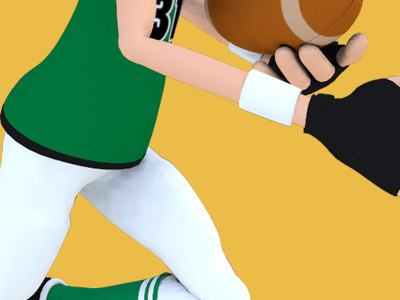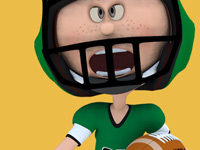American football

American Football Tackle
Most forms of football have a move known as a tackle. The primary and important purposes of tackling are to dispossess an opponent of the ball, to stop the player from gaining ground towards goal or to stop them from carrying out what they intend.
The word is used in some contact variations of football to describe the act of physically holding or wrestling a player to the ground. In others, it simply describes one or more methods of contesting for possession of the ball. It can therefore be used as both a defensive or attacking move.
Name origin
In Middle Dutch, the verb tacken meant to grab or to handle. By the 14th century, this had come to be used for the equipment used for fishing, referring to the rod and reel, etc., and also for that used in sailing, referring to rigging, equipment, or gear used on ships. By the 18th century, a similar use was applied to harnesses or equipment used with horses. Modern use in football comes from the earlier sport of rugby, where the word was used in the 19th century.
American and Canadian football
In American football and Canadian football, to tackle is to physically interfere with the forward progress of a player in possession of the ball, such that his forward progress ceases and is not resumed, or such that he is caused to touch some part of his body to the ground other than his feet or hands, or such that he is forced to go out of bounds. In any such case, the ball becomes dead, the down is over, and play ceases until the beginning of the next play. A tackle is known as a quarterback sack when the quarterback is tackled behind the line of scrimmage while attempting to throw a pass. A tackle for loss indicates a tackle that causes a loss of yardage for the opposing running back or wide receiver. This happens when the quarterback is sacked, when either a rusher or a receiver is tackled behind the line of scrimmage, or when the ball is fumbled behind the line of scrimmage and was picked up by an offensive player who does not manage to move past the line before being tackled. When a player who does not have the ball is taken down it is generally referred to as a block. Tacklers are not required to wrap their arms around the ball carrier before bringing him to the ground; in fact, the ball carrier is often "tackled" by the defender taking a running start and hitting the ball carrier to knock them to the ground. Tackles can also be made by grabbing the ball carrier's jersey and pulling him to the ground. As mentioned above, the referee can declare that a play is dead if the ballcarrier's forward progress has been stopped, even if no actual "tackle" has occurred.
There are some restrictions on tackles and blocks. At no time may a defensive player tackle an offensive player by grabbing the facemask of a football helmet; doing so incurs a 15-yard penalty and the victimized team is awarded a new set of downs. Although spear tackles are allowed in gridiron football, a player may not use his helmet to tackle an opponent as the technique can cause serious injury to both players (more often the tackler, due to the force of reaction on the tackler, which is apt to be beyond the limit that the neck can handle) and also warrants a 15-yard penalty as well as a fresh set of downs if committed by the defending team; this is known as "spearing the player." A similar penalty is assessed to any player attempting to make contact with his helmet against another opponent's helmet, which is known as a helmet-to-helmet collision. Grabbing a ball carrier by the pads behind his neck and pulling him down is known as a "horse collar," a method which has been made illegal at all levels of American football.
It is also illegal to tackle a player who has thrown a forward pass (generally a quarterback) after he has released the ball; doing so is called "roughing the passer" and incurs a 15-yard penalty and a fresh set of downs for the team with the ball. However, in the NFL a player can continue forward for one step, which means that often a player who is committed to attacking the quarterback will still make a tackle. Place kickers and punters are afforded an even greater protection from being tackled. Once the play is ruled complete no contact is permitted; a player who makes contact with an opponent after the play is charged with "unnecessary roughness" and his team is assessed a 15-yard penalty. Blocks that occur in the back of the legs and below the knees, initiated below the waist, or clotheslines are also generally prohibited and players who use them are subject to much more severe penalties than other illegal tackles. However a player who plays on the line can block below the knees (cut block) as long the block is within five yards of the line and the player they block is in front of them and not engaged by another blocker (chop block).
In the National Football League (NFL), tackles are tracked as an unofficial statistic by a scorekeeper hired by the home team. Though the statistic is widely cited, the league does not verify that the counts are accurate.
SPORTS



American Football
Game play in American football consists of a series of downs, individual plays of short duration, outside of which the ball is dead or not in play. These can be plays from scrimmage – passes, runs, punts, or field goal attempts (from either a place kick or a drop kick) – or free kicks such as kickoffs and fair catch kicks. Substitutions can be made between downs, which allows for a great deal of specialization as coaches choose the players best suited for each particular situation. During a play, each team should have no more than 11 players on the field, and each of them has specific tasks assigned for that specific play.
Rules and gameplay
- Scoring
- Maneuvers
- Strategy
- Play types
- Penalties
- Turnovers
- Downs
- Teams and positions
- Field
- Equipment
- Duration and time stoppages
- Advancing the ball and downs
- Kicking
- Officials and fouls
Positions
Offensive (Interior) line
Backs and receivers
Defensive line
Linebackers
Defensive backs
Special teams
- Kicker (K)
- Holder (H)
- Long snapper (LS)
- Punter (P)
- Kickoff specialist (KOS)
- Kick returner (KR) and Punt returner (PR)
- Upback
- Gunner
- Jammer


RESOURCES
This article uses material from the Wikipedia articles "American football", "American football rules", "Tackle (football move)", which is released under the Creative Commons Attribution-Share-Alike License 3.0.
© Stories Preschool. All Rights Reserved.





